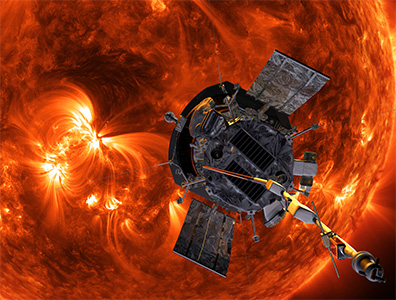Space Dust Presents Opportunities, Challenges as Parker Solar Probe Speeds Back to the Sun
Posted on 2021-11-10 14:44:47Propelled by a recent swing past Venus, NASA’s Parker Solar Probe is healthy and performing normally as it heads toward its next closest approach to the Sun on Nov. 21.
Parker Solar Probe will break its own distance and speed records on that approach – the 10th of 24 planned, progressively closer trips around the Sun – when it comes about 5.3 million miles (8.5 million kilometers) from the Sun's surface, while reaching top speeds of 101 miles (163 kilometers) per second, or 364,621 miles per hour. The probe’s science instruments are already queued up to measure the properties of the solar wind near its source, but the spacecraft is also making other critical, if not unexpected, discoveries.
“We’re observing higher than expected amounts of dust near the Sun,” said Nour Raouafi, Parker Solar Probe project scientist at the Johns Hopkins Applied Physics Laboratory (APL) in Laurel, Maryland. “What’s exciting about this is it’s greatly improving our understanding of the innermost regions of our heliosphere, giving us insight into an environment that, until now, was a total mystery.”
Parker Solar Probe designed, built and now operated at APL, does not carry a dust detector. But as dust grains pelt the spacecraft along its path, the high-velocity impacts create clouds of plasma. These clouds produce unique electrical charges that are picked up by several sensors on the probe's FIELDS instrument, which is designed to measure the electric and magnetic fields near the Sun. Mission scientists have used this data, for example, to construct comprehensive pictures of the structure and behavior of the large cloud of dust that swirls through the innermost solar system.
The visible imaging camera, WISPR, also picks up bits of material expelled from the spacecraft’s structures after impact with those dust grains. But it also images dust structures far away from the spacecraft, such as the dust ring that shares Venus’ orbit. While learning about space dust isn’t a prime mission science goal, the WISPR and FIELDS have planned for specifically investigating near-Sun dust – in a region of the solar system where no mission has ever operated.
The Parker Solar Probe team did prepare for the spacecraft’s precarious trek through this potentially hazardous environment – as early as the initial mission concept phase – at least as well as our scientific community understood it before the probe’s 2018 launch.
“We designed materials and components that survive hypervelocity dust impacts and the effects of the even smaller particles created in these impacts,” said Jim Kinnison, Parker Solar Probe mission systems engineer at APL. “We modeled the makeup and effects of the dust environment, tested how materials react to the dust particles, and installed fault-tolerant onboard systems that are keeping Parker Solar Probe safe in this unexplored region.”
The spacecraft team has noticed that occasionally, the star tracking cameras used as part of the guidance and control system see reflected light from dust and shattering particles that can momentarily disrupt their ability to see stars. Kinnison noted, however, that this doesn’t compromise the safety of spacecraft or instrument operations, and the star trackers aren’t the spacecraft’s only method of controlling where it points. The guidance and control software uses data from the star trackers in tandem with an inertial measurement unit and solar-limb sensors to keep the Thermal Protection System – the heat shield – pointed toward the Sun.
“Because the system was built to be robust and highly autonomous, loss of data from any one source doesn’t affect the ability to control the spacecraft attitude, and in a worst-case situation, can work indefinitely with just the solar limb sensors that watch for unexpected solar illumination on the spacecraft due to attitude errors,” he said. “With PSP now in its 10th orbit around the Sun, the spacecraft is proving it can handle this unexpected dust environment.”
And that’s good news, he added, with Parker Solar Probe only set to move closer to – and faster around -- the Sun. Assisted by two more Venus flybys, in August 2023 and November 2024, Parker Solar Probe will eventually come within 4 million miles (6.2 million kilometers) of the solar surface in December 2024, at speeds topping 430,000 miles per hour.

2021-11-10
Credit: NASA/Johns Hopkins APL
High-Res Image